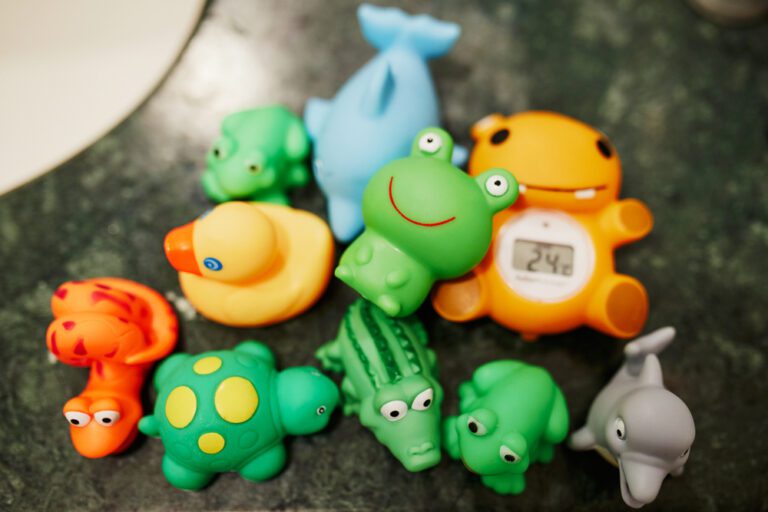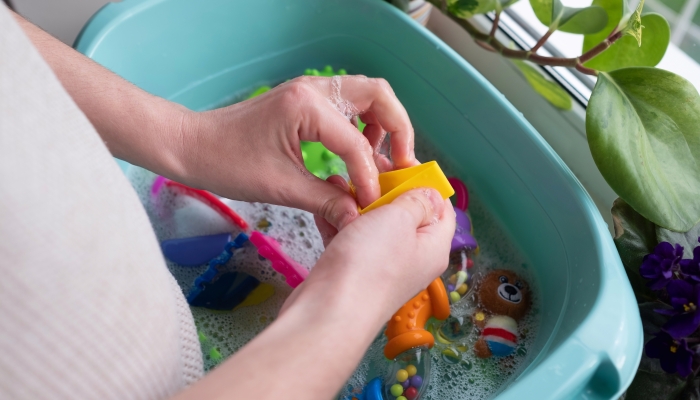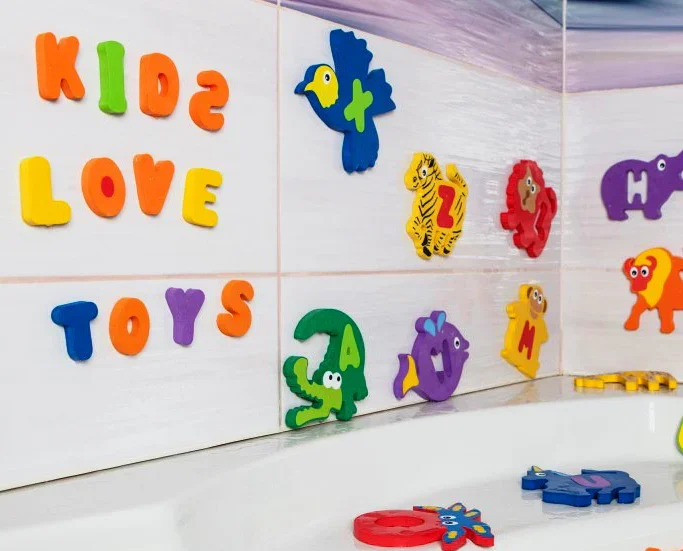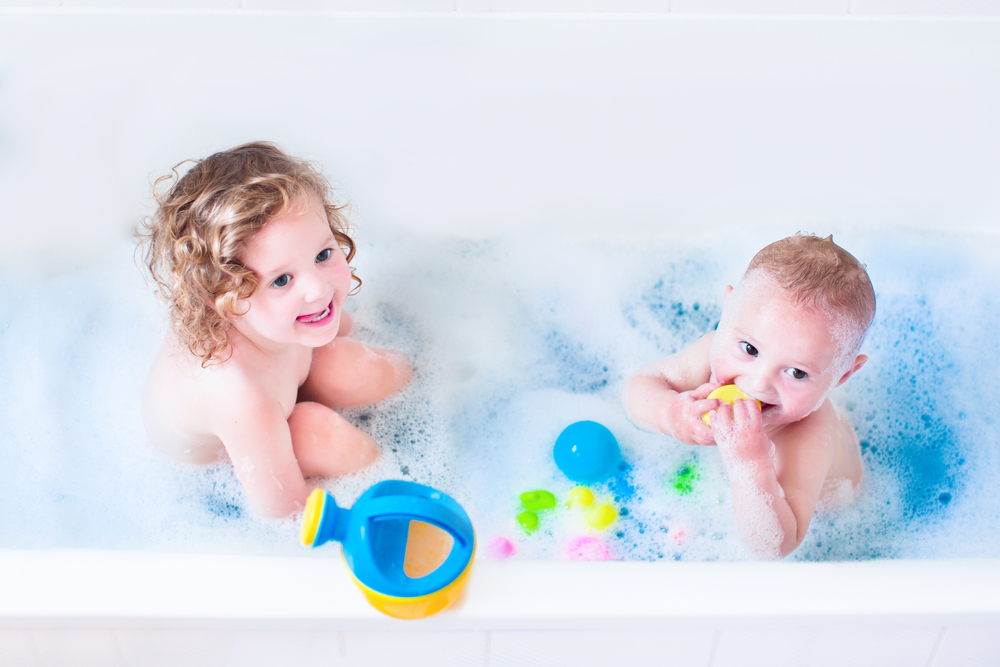Bath time is supposed to be a fun, safe experience, but dirty bath toys can turn it into a health hazard. Knowing how to clean bath toys properly is a matter of health. These cheerful rubber duckies and foamy alphabet letters may look innocent, but they can harbor harmful mold and bacteria if left unchecked.
- Why You Should Clean Bath Toys Regularly
- Signs of Mold on Toys
- How to Clean Mold from Bath Toys
- Simple Cleaning Of Tub Toys
- Gunk Inside Squirty Toys? Let’s Talk About It
- Best Way to Clean Bath Toys
- How to Disinfect Bath Toys
- How to Sanitize Bath Toys Without Harsh Chemicals
- Daily Toy TLC: Quick After-Bath Cleanups
- How to Keep Bath Toys from Molding
- Say Goodbye to Squirters
- Clean Foam Toys For Bath
- How To Clean Bath Toy Letters
- Spot the Moldy Toy Before It Gets Worse
- How to Disinfect Bath Toys After Poop Accidents
- FAQ’s
So, how do you clean bath toys effectively? Whether it’s a weekly wipe-down or a rescue operation for moldy bath toys, this guide will walk you through it.
Why You Should Clean Bath Toys Regularly
You might be surprised, but mold can begin to grow inside bath toys in as little as 24 hours. Mold on toys is not just gross; it can lead to respiratory issues, skin irritation, and even infections—especially in babies and toddlers. So cleaning baby bath toys becomes crucial when you consider that kids often put them in their mouths.
Mold thrives in moist, dark places—exactly what a water-filled toy provides. That’s why mold in bath toys is common, especially in squeeze toys with holes at the bottom. The interior becomes a breeding ground for mildew.
If you’ve noticed a musty smell or black specks (aka black stuff in the bathtub), it’s a sign you may need to learn how to clean bath toys with mold inside urgently.
Here’s the deal: mold on toys is more common than spilled shampoo. The warm, moist environment of a tub makes bath toys the perfect petri dish for bacteria and black fungus. Kids squeeze water in, forget to squeeze it out, and boom—moldy bath toys.
The Black Stuff in the Tub: What Is That?
If you’ve noticed dark, slimy residue coming from squeeze toys in the bath, you’ve probably encountered mold—a common issue with bath toys.
Don’t worry, though! It’s a manageable problem, and in the next sections, we’ll explain how to tackle it and keep your little one’s bath time clean and safe.
Signs of Mold on Toys
Here’s what to look out for:
- Visible black or green spots
- Strong, sour odor
- Slime-like residue
- Toy feels heavier than normal (indicating water inside)
When you spot these signs, it’s time for cleaning bath toys using powerful yet safe methods.
How to Clean Mold from Bath Toys
Here’s How To Clean Toys With Bleach

First, squeeze out as much trapped water as possible. Then:
- Mix a bleach solution: 1 tablespoon of bleach to 1 gallon of water.
- Soak for at least 5 minutes.
- Rinse thoroughly.
- Let them dry completely, ideally in sunlight.
Cleaning toys with bleach is effective but needs to be handled with care. Always wear gloves and ensure proper ventilation.
Clean Bath Toys With Vinegar
Prefer a natural route? Here’s the clean bath toys vinegar method:
- Mix equal parts white vinegar and warm water.
- Soak toys for 10-15 minutes.
- Scrub with a toothbrush, especially around crevices.
- Rinse and air dry fully.
More Natural & Nifty Method
This method is perfect for sanitizing toys with vinegar—gentle on baby skin but tough on germs.
- Mix baking soda and lemon juice into a paste
- Scrub toys with it for a chemical-free clean
- Rinse with hot water
- Dry like your life depends on it (because it kind of does)
Simple Cleaning Of Tub Toys
Daily quick-clean idea:
- Rinse with hot water.
- Towel dry or use a drying rack.
- Rotate toys to avoid repeated moisture exposure.
This daily habit makes cleaning tub toys effortless.
Clean Bath Toys Mold Inside
You’ll need:
- A chopstick
- Cotton swabs
- Toothpicks
- Pipe cleaners
Dip in vinegar or peroxide to scrub tight spots. For squeeze toys, consider sealing the holes with hot glue. Reddit users swear by this technique!
Wash Bath Toys
Make it a weekend routine:
- Gather toys
- Use dishwasher-safe options
- Spot-clean with vinegar spray
- Rinse and dry
This simple habit keeps your clean bath toys in great shape and your little ones healthier.
Gunk Inside Squirty Toys? Let’s Talk About It
You squeeze, and… yuck. Mold water.
Here’s how to clean bath toys with mold inside:
- Fill a basin with equal parts vinegar and water
- Submerge toys for 15–30 minutes
- Scrub tight spots with a bottle brush or toothbrush
- Rinse, then air dry completely
Trust us—clean bath toys with vinegar methods work wonders without harsh chemicals.
Best Way to Clean Bath Toys
Comparing methods:
Method |
Pros |
Cons |
| Bleach | Kills 99.9% germs | Harsh chemicals |
| Vinegar | Natural, safe | Takes longer |
| Dishwasher | Quick, no scrubbing | Not all toys are dishwasher safe |
So, the best way to clean bath toys depends on your preference and the toy material.
How to Disinfect Bath Toys
Disinfecting baby toys goes beyond cleaning. Use:
- Hydrogen peroxide spray (3% solution)
- Boiling water (for heat-resistant toys)
- Dishwasher sanitize cycle (top rack only)
This is the best way to sanitize baby toys between regular cleanings.
How to Sanitize Bath Toys Without Harsh Chemicals

To truly sanitize toys, sometimes you need to go nuclear. Here’s what kills the bad stuff:
- Bleach soak: 1 tablespoon bleach per gallon of water, soak for 5–10 minutes
- Hydrogen peroxide spray: Less harsh, still effective
- Dishwasher sanitize cycle: Pop those toys on the top rack
Need to clean after a #poopocalypse? Learn how to disinfect bath toys after poop immediately to prevent the nasties from sticking around.
Daily Toy TLC: Quick After-Bath Cleanups
To stop mold before it starts:
- Squeeze out excess water (every time!)
- Rinse with hot water
- Store toys in a mesh bag or drying rack
Doing this will make clean bath toys your reality, not a dream.
How to Keep Bath Toys from Molding
How to keep bath toys from molding in one word? Dry.
Prevention is better than cure:
- Store toys in a mesh bag or drying rack.
- Squeeze water out after every bath.
- Avoid hollow toys or seal them.
Bath toys that don’t mold include brands like Boon, Green Toys, and Munchkin.
Use:
- Hanging nets
- Mesh baskets
- Open-air shelving
Also, rotate toys weekly. Moisture is mold’s BFF—cut off the relationship.
Choose Mold Resistant Bath Toys
Look for:
- No holes
- BPA-free plastic
- Silicone-based materials
These mold-resistant bath toys last longer and are safer.
Say Goodbye to Squirters
Toys with holes are the worst offenders. Either:
- Plug them with hot glue
- Or… throw them out (honestly, sometimes it’s not worth it)
That’s how you win the war against bath toys and mold.
Clean Foam Toys For Bath
Foam bath toys soak up water like sponges. That means:
- Regular vinegar soaks
- Gentle scrubbing with a brush
- Drying flat—never stacked!
That’s how to extend the life of your foamy pals.
How To Clean Bath Toy Letters
Bath toy letters, especially foam ones, can be a breeding ground for bacteria and mold, particularly since kids often chew on them during bath time. To keep them safe, it’s important to sanitize them regularly.

A simple way to clean foam toys is to soak them in a vinegar solution, which helps kill germs and mold. After soaking, scrub them gently to remove any buildup, and then lay them flat on a towel to dry thoroughly. Regular cleaning ensures your child’s bath toys remain hygienic and safe for use.
- Store flat
- Avoid storing them stuck to the tub wall!
Spot the Moldy Toy Before It Gets Worse
Telltale signs it’s time for action:
- Toy smells “off”
- Black or brown residue
- Feels slimy
- Discolored inside
Time to decide if you should clean or toss.
How to Disinfect Bath Toys After Poop Accidents
It happens. Here’s what to do:
- Remove toy immediately.
- Rinse under hot water.
- Soak in bleach solution for 10 minutes.
- Rinse thoroughly.
- Dry completely.
Always wear gloves and sanitize the tub afterward to prevent bathtub fungus growth.
FAQ’s
1. What are the top best baby bath toys?
Some of the best baby bath toys include Munchkin Float and Play Bubbles, Boon Building Bath Pipes, and Green Toys Submarine. They’re safe, mold-resistant, and easy to clean.
2. What are some of the best bath toys for a 2 year old?
Great bath toys for 2-year-olds are foam alphabet letters, stacking cups, and squirty animals (with sealed holes). These toys help with learning and motor skills during bath time.
3. What safety features should I look for in baby toys?
Always check for BPA-free labels, no small detachable parts, and smooth edges. Non-toxic materials and mold-resistant designs are must-haves for bath toys.
4. Are baby bath seats safe?
Bath seats can be safe when used under strict adult supervision and in shallow water. However, they are not a substitute for hands-on monitoring during bath time.
5. How to keep my baby toys safe?
Clean them weekly, dry them after every use, and store them in a dry place. Regularly inspect for mold, cracks, or signs of wear.
6. How to ensure my baby’s toys are clean and safe to play with?
Use natural cleaners like vinegar or approved sanitizers, rinse well, and dry thoroughly. Avoid toys with holes that can trap water inside.
7. Are wooden or plastic toys better for babies, and why?
Both have benefits—wooden toys are eco-friendly and durable, while plastic toys (if non-toxic and BPA-free) are easier to clean and sanitize, especially for bath time.
8. How to know if my baby toys aren’t toxic?
Look for safety certifications like ASTM, EN71, or CPSIA. Also, choose brands that are transparent about their materials, labeling them as BPA-free and phthalate-free.








